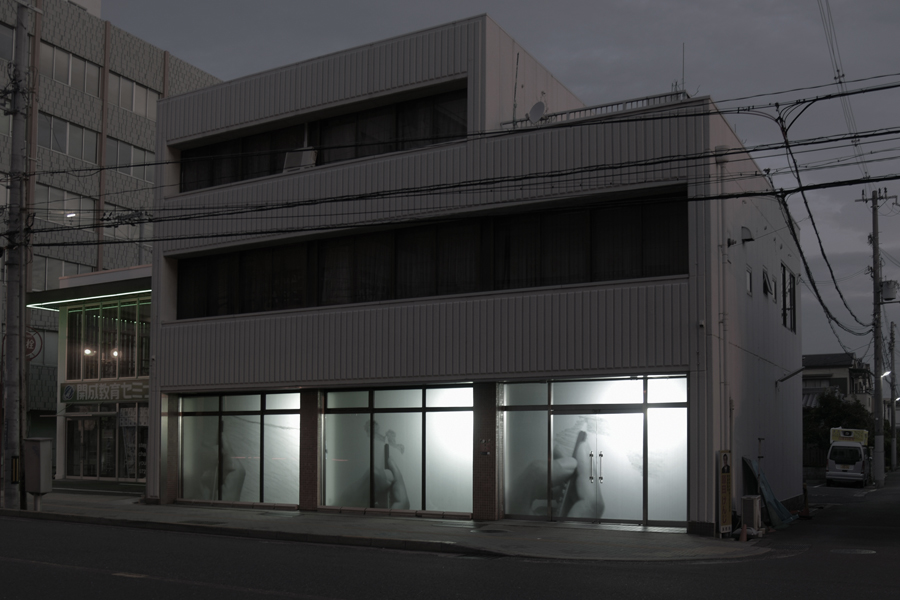
←
←
motonoriinagaki.com
Copyright © 2012 Motonori Inagaki All Rights Reserved.
←
かたちが意味になる前に 稲垣元則《The Light》の場合
断片的で、未完成で、情報量にとぼしい……こうした、通常ならネガティヴに響く形容の数々が、稲垣元則の作品においては、一転して肯定的な価値を得る。つまり、「分からなさ」こそが稲垣芸術の本質である、というわけだ。どういうことか。
2018年の春から夏、およそ半年にわたり上映された作品《The Light》を例に取ろう。鉛筆でたどたどしく線を引いていく手、静かにたゆたう波、風にそよぐ花々、等々と、そこに映しだされる出来事はたしかに緩慢で、もしかしたら退屈ですらあるかもしれない。だが問題は映像の中身でなく、むしろ作品が置かれる外的な状況のほうである。それもそのはず、《The Light》が上映される場所は、サワラギヤという民間の店舗、大阪府茨木市内を走る府道沿いの日常空間であるからだ。しかも、上映時間は日没から日の出までの夜間に限定されている。
店舗のガラス戸に投影される本作品を、ひとは外から、より厳密には道路の向こう側から眺めることになるだろう。長辺10メートルほどもある画面を一望しようと思えば、どうしても作品に対して距離を取らざるをえず、逆にその「正しい」鑑賞位置からはずれたら(たとえば、たまたま店舗のすぐ脇を通り過ぎる者にとって)、《The Light》は作品である以前、茫洋たる光の塊としてしか認知されないはずである。ひとはこの作品になかなか気づけないし、仮に運よく気づいたとしても、今度はその意味するところがよく分からない。
このように稲垣の手がける作品は、違和感、あるいは不可解さをこそ重視する。頼りなげな描線や色斑による素描も、また白黒に変換され匿名化された風景写真も、その目指すところに変わりはない。意味づけられること、言葉で説明されることへの抵抗。ひとつの意味に固定されず、いつでも「別の何か」に変転しうる余地を残しておくことが、その仕事の中核だと言えよう。稲垣芸術の「分からなさ」は、何も説明しないことを、つまりは前-意味的にただ在ることだけを追求した帰結である。
では、その「前-意味」性とでも呼ぶべきものは、私たちに何をもたらすか。いまいちど《The Light》を例に取るならば、この問いに対する答えもまた、作品が設置された場所から浮かび上がってくる。野外の日常空間にありながら、声高に注目を集めることもしないその寡黙な作品は、ある種の異物として、「日常」であることそれ自体に風穴をうがつだろう。ふだんの私たちは、目にするもの、行動することの一つ一つにあえて注意を払わない。意味で織り上げられた世界、いちいち立ち止まって考える必要のない「分かりきった」日々を生きているからだ。だが、存在理由の定かならぬ《The Light》のような作品は、そんな日常を、居心地悪く塗り替える。「いま、私は何を見ているのか」と素朴に問い、日々の流れにささやかな竿を差す、そんな態度を起動するためのトリガーがこの作品だと言えようか。
アートを活用したまちづくり、という名目のもとに生みだされた《The Light》であるが、その貢献のありかたは決して分かりやすいものではない。だが意味以前にとどまろうとする稲垣の実践は、より根源的に、私たちの生と関わっている。
福元 崇志 Takashi Fukumoto(国立国際美術館研究員)
Before Form Becomes Meaning: Motonori Inagaki, "The Light"
Fragmentary, incomplete, and lacking in information ......, these usually negative-sounding descriptions of Motonori Inagaki's work take on a whole new, positive value. In other words, "unknowability" is the essence of Inagaki's art. What does this mean?
Take the example of "The Light," a work that was shown for about six months from spring to summer of 2018. The events shown in the film are indeed slow and perhaps even tedious: a hand drawing a line with a pencil, waves gently swaying, flowers rustling in the wind, etc. But the problem is not the content of the images, but rather the way they are shown. However, the problem is not the content of the images, but rather the external circumstances in which they are placed. The problem is not so much the content of the images, but rather the external circumstances in which the work is placed. Moreover, the screening hours are limited to nighttime, from sunset to sunrise.
The work is projected on the glass door of the store, and people are expected to view it from outside, or more precisely, from the other side of the road. If one wants to get a bird's-eye view of the 10-meter-long screen, one has no choice but to stand at a distance from the work. The Light" would not be a work of art at all. People would have a hard time noticing this work, and even if they were lucky enough to notice it, they would not understand its meaning.
Thus, Inagaki's works emphasize the sense of discomfort or inexplicability. Whether it is a drawing with unreliable lines and color patches, or a landscape photograph that has been converted to black and white and anonymized, his goal remains the same. The work resists being given meaning, or being explained by words. The core of Inagaki's work is not to be fixed on a single meaning, but to leave room for something else to emerge at any time. The "unknowability" of Inagaki's art is the result of his pursuit to explain nothing, in other words, to simply exist in a pre-meaningful way.
What does this "pre-meaning" bring to us? If we take "The Light" as an example, the answer to this question also emerges from the place where the work is installed. The work, which is located in an everyday outdoor space and does not draw attention to itself loudly, is a kind of foreign object that will cause a hole in what is "everyday" in itself. We do not pay attention to each and every thing we see or do. This is because we live in a world woven with meaning, a world in which we do not need to stop and think about every single thing we see or do. However, works such as "The Light," whose reason for existence is not clear, make us feel uncomfortable and repaint our daily lives. This work is a trigger to start up such an attitude of simply asking, "What am I looking at right now?
The Light" was created under the title of "community development through art," but its contribution is by no means easy to understand. However, Inagaki's practice of staying before meaning is more fundamentally related to our lives.
Takashi Fukumoto (Researcher, The National Museum of Art, Osaka)
[by automatic translation]

←
←
motonoriinagaki.com
Copyright © 2012 Motonori Inagaki All Rights Reserved.